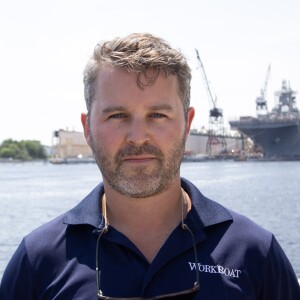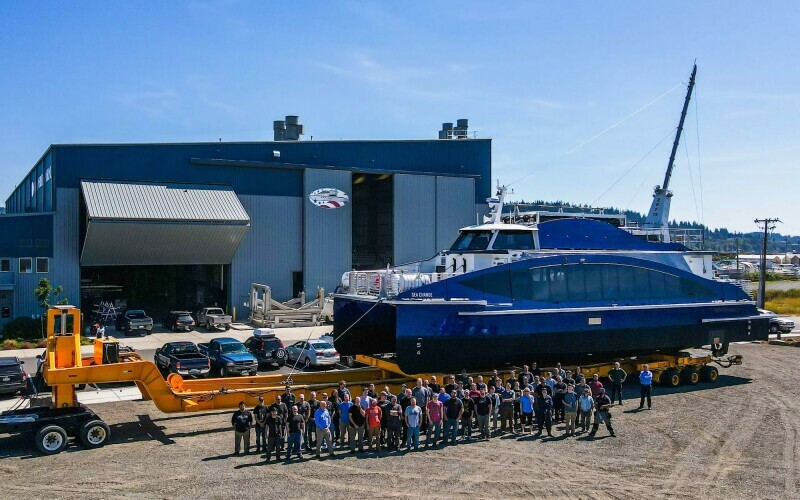Efforts have escalated in recent years in the maritime industry to shrink its carbon footprint. Such efforts have made words and phrases like decarbonization, electrification, and greenhouse gas (GHG) reduction commonplace. — the environmental and technical benefits and challenges to reducing GHG emissions in the industry.
“What is it going to take to transition this industry into something that doesn’t generate greenhouse gases?” David Cummins, president and CEO Blue Sky Maritime Coalition (BSMC), asked the audience at this year’s Inland Marine Expo (IMX) in Nashville, Tenn.
Cummins said the problem needs to be solved through an industrywide approach, and not be left to individual companies to figure out.
“We had to look beyond the vessel itself, to the ports and the fuel providers, as well as the engine manufacturers and the class societies, government and academia, and other nonprofits,” Cummins said during an IMX education session on “Decarbonizing Your Marine Operations.”
He said the significance and unknowns of industry decarbonization are represented by the growth in BSMC’s membership numbers. In 18 months, the coalition has increased from 22 original members to 110.
At the heart of BSMC lies the spirit of collaboration. Comprising governments, shipping companies, environmental organizations, and technology innovators, this global alliance harnesses collective expertise and resources to drive change. By fostering partnerships and knowledge sharing, the coalition aims to accelerate the development and adoption of sustainable maritime technologies.
RENEWABLE DIESEL, BIODIESEL
Also on the panel was John Scharingson, executive director, Chevron Renewable Energy Group. He laid out Chevron’s high-level strategy, and where his company believes the industry is headed.
“In 2021, Chevron sold 732 million gallons of renewable fuel, globally,” said Scharingson. “About 90% of that was in the United States, which was comprised of 395 million gallons of biodiesel, 138 million gallons of renewable diesel, and 179 million gallons of petroleum products that we use to blend with biodiesel and renewable diesel.”
Chevron is investing $8 billion in its Geismar, La., renewable diesel facility, which will increase production capacity from 100 million gals. per year to 350 million gals. per year. That plant is expected to come online by the second quarter of 2024, making it the second-largest renewable diesel plant in North America, and the third largest in the world. “By this time next year, Chevron will have about 750 million gallons of annual production capacity of biodiesel and renewable diesel,” he said. “By 2030, our strategy intends to have 1.5 billion gallons of global production capacity.”
Both speakers noted the inexactness with longer-term alternative fuels. “Nobody knows what technology is going to win,” said Scharingson, “so we think we have a tremendous bridging solution with renewable diesel and biodiesel because those products are made at scale. For every gallon of renewable diesel, or biodiesel that replaces a gallon of MGO (marine gas oil), or LSFO (low sulfur fuel oil), or HSFO (high sulfur fuel oil), it’s 100 percent CO2 emission reduction today.”
Sharingson said biofuels are better than electrification. “Renewable diesel and biodiesel, in both the brownwater and blue water space, no engine modifications are required. That technology is available today. Hydrogen, green methanol, and green ammonia are certainly part of the solution, but vessel life expectancy and CapEx investments in new technologies will prolong their implementation.”
Cummins stressed that Blue Sky’s focus is on regulatory frameworks, not alternative fuels. “We’re very agnostic about fuels. And, frankly, that’s not the most important thing for us to be working on today,” he said. “When you look at that vision of the future and work backward, we need to be working in a totally different way. What are the barriers to decarbonization, or to the removal of greenhouse gas emissions? Yes, they’re going to come from new technologies and fuels and infrastructure, but they’re also going to come from different types of policies and regulations.”
Cummins said there are barriers in the ways that policymakers work with
Carbon Intensity Indicator (CII) scores were discussed by both speakers.
Blue Sky conducted a study that illustrated the flaws that exist with carbon measurement methods currently proposed by the IMO, specifically CII
“The only thing that’s different about them is that they do different types of service,” said Cummins. “And the ones that do short-haul service get a CII score anywhere from B, which is pretty good, to E, which is when you’re about ready to pull it out of service. And there is nothing less efficient about either. It is just what you choose to do with it.”
He cited the need to directly measure emissions to establish a baseline, the need to work with real data and not calculations that are based off an engine under ideal conditions. To do this, three of Blue Sky’s members have installed measuring devices on their vessels, and “the learnings have been through the roof,” according to Cummins. “On an LNG vessel, we found out that if you slow steam, it is way worse for the environment because you dramatically increase the methane slip. It’s not about what’s getting burned in your engine. It’s not about what the engine manufacturer’s numbers were.”
On that same vessel, BSMC also found out that 95% of its engine emissions were coming at station. To resolve that, the vessel company put batteries onboard and is running a net zero emission operation from time to time on LNG and batteries.
“Climate change is real. I don’t care if you believe it or not,” Scharingson said. “If Exxon and Chevron can acknowledge it’s real, it’s real. I spend about half my time calling on large fleets like Amazon, PepsiCo, Walmart, and FedEx. They are all willing to pay a premium today in excess of this relatively scarce commodity that is low-carbon fuels. The demand for low-carbon fuels is not going away."




